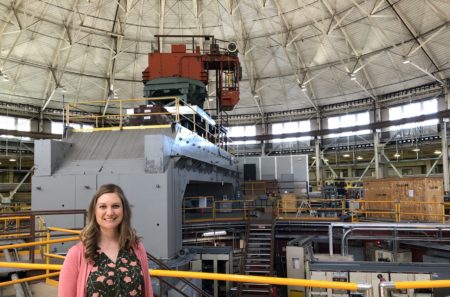 Stephanie Gilbert Corder is the newest beamline scientist at the ALS. Having been an ALS user in the past, she is eager to help others get reliable measurements to make the most of their beamtime.
Stephanie Gilbert Corder is the newest beamline scientist at the ALS. Having been an ALS user in the past, she is eager to help others get reliable measurements to make the most of their beamtime.
What is your role at the ALS?
I’m the new infrared (IR) beamline scientist working with Hans Bechtel. One of the big pushes with IR beamlines worldwide is near-field microscopy which provides IR spectral information with tens of nm spatial resolution. We have two incredible, popular setups at the infrared beamlines that work at ambient pressure and temperature, 2.4 and 5.4, so we are working on expanding the capabilities. Presently, it’s ambient pressure and temperature. We’re looking at different ways to provide more extreme environments and add excitation sources.
How did you become interested in this work?
My background is in near-infrared spectroscopy. When I was a graduate student, my focus was materials characterization: looking at many different materials with ultrafast as the main technique to understand electron dynamics, and then having supporting techniques, like FTIR, Raman, and ellipsometry to understand what was really going on in the ultrafast response.
While I was a graduate student at Vanderbilt University, I interned at the original NSLS synchrotron with Larry Carr, who was directing the infrared beamlines there. I was able to learn about synchrotron work and take some really beautiful time-resolved magneto-spectroscopy measurements. I loved working at the synchrotron and coming to the beamline day after day, so that was my goal from that point on, to be a research scientist at a national lab.
When I was a postdoc at Stony Brook University, my advisor, who had been a frequent user of the infrared beamlines here, arranged for me to take measurements at Beamline 5.4 with Hans. Those measurements became key results in our research group’s first couple papers, and were critical to getting our research program off and running. As a graduate student, I primarily worked with semiconductors. When I started my postdoc, we studied some biomaterials but mostly focused on phase transitions in strongly correlated materials and transition metal oxides—a completely different region of the periodic table from what I was used to. It was fun to learn something new. Now, I’m really excited about the prospect of users bringing in interesting samples and getting to learn about different materials new every week.
What are your goals for the infrared beamlines?
I want the users to be successful! I’ve recently been in their place, and I know how important it can be to get good measurements quickly and reliably. My goal is to make all the procedures that we have for using the equipment as straightforward as possible and provide the best help that I can. I enjoy working with people, and I look forward to hearing about their projects and their goals. I also welcome suggestions for what they would like to see in the infrared beamlines in terms of expanded capabilities.
I’d like to enable collaborations between the different measurement types available at the ALS. It would be wonderful to facilitate complementary measurements with some of the x-ray beamlines or design a sample holder that can go between many different experiments. Everybody wants to maximize the time that they have here, so if they can do all sorts of cool things and get really great results, that will ultimately be even better for their projects. In my experience, because nano-FTIR is a relatively new technique, reviewers challenged what we were seeing. They always wanted to see supplemental data, so we ended up sending samples to collaborators doing micro-XRD to get our work published. I want to facilitate multimodal measurements and anticipate requirements so that we don’t have to drag out the publication time for excellent work.
What do you like to do in your spare time?
I like to go hiking with my family and my dog. We spend a lot of time outdoors, so we were really excited about moving here from the East Coast. I enjoy gardening and running, although I have a toddler, so I don’t really have a whole lot of time—running after my daughter is probably a hobby at this point. I really enjoy the arts, going to an art museum or seeing a musical or play. I enjoy working with my hands, so being an experimentalist is a natural fit.